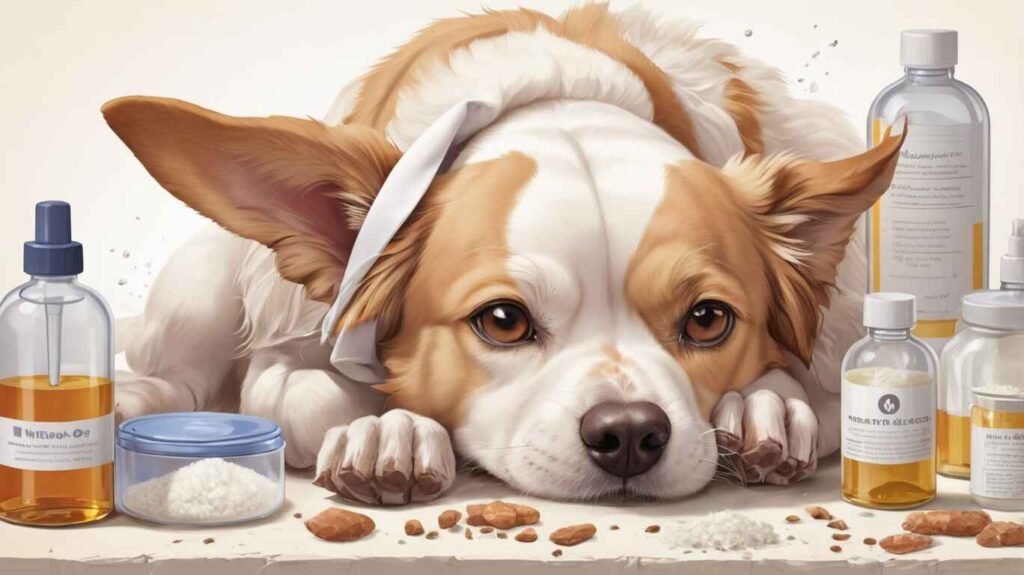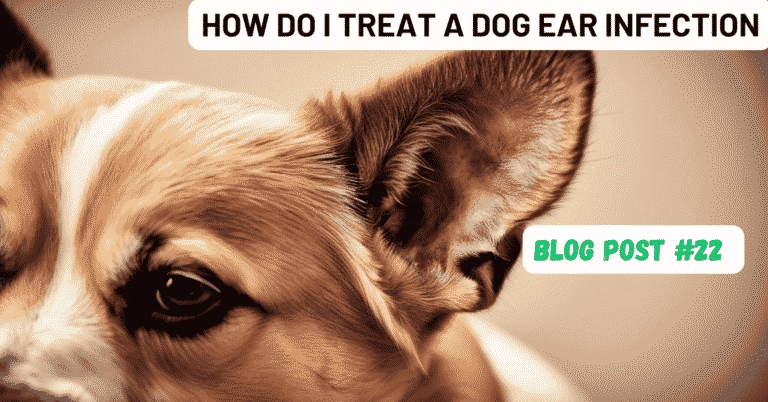By Tom, CCDT-Certified Dog Trainer (10+ Years Border Collie Experience)–With advisory review by Dr. Sarah Thompson, DVM (DACVD)
How do I treat a dog ear infection is a question you’ll ask yourself when your dog is experiencing a distressing phase of discomfort and uneasiness. An ear infection is a serious issue in a dog’s life.
There are many things that are related directly and indirectly to ear infections of a dog, and owners unknown about it often ignore ear scratching of their pet dog.
We will try to guide our readers and help you understand the causes, symptoms, and treatment required for ear infections so that you can give your furry friend a healthy, quality, and stress-free life.
83% of home-treated ear infections worsen due to incorrect medication use. Here’s how to avoid common mistakes.”*
– 2023 AAHA Canine Ear Care Guidelines
Contents
Understanding Ear Infections-How Do I Treat A Dog Ear Infection

What is an Ear Infection?
An Ear Infection can occur as a dog’s ear canal is invaded by parasites or yeast and bacteria, which leads to inflammation and irritation. But the most commonly affected part of the ear is the outer ear canal; in medical terms, it is called Otitis Externa. However, the infection can reach the middle and inner parts also.
Let’s understand the three distinct areas in which infection occurs.
Otitis Externa is an inflammation in the external ear canal. It is caused by allergies, bacteria, yeast, and ear mites, mainly affecting the outer ear canal. It is the most common type of inflammation found in dogs. This inflammation causes redness and swelling in the ears and sometimes even discharge.
Otitis Media inflammation occurs in the middle part of the ear. It stems from existing Otitis Externa and spreads in the middle part of the ear. Otitis Media requires immediate care because it can affect hearing capacity and can permanently damage the ear if not treated.
This inflammation also depends on the ear structure; for example, dog breeds with long and floppy ears can trap moisture and dirt. Breeds like cocker spaniels, poodles and basset hounds need extra care and attention to ear hygiene.
Otitis Interna is inner ear inflammation and is a serious condition that can permanently damage hearing. It is caused by untreated otitis media(inner ear structure). Dog can show problems like head tilting, ear scratching, difficulty in walking, and pain when opening and chewing food.
Confirm It’s Really an Infection
Symptoms Checklist
✅ Yeast Infection
- Smells like corn chips
- Dark brown waxy discharge
- Head shaking (3+ times/hour)
✅ Bacterial Infection
- Yellow/green pus
- Hot to touch
- Painful when touched
🚨 ER Warning Signs
- Head tilt + circling (vestibular disease)
Facial swelling (allergic reaction)
Causes Of Ear Infection
Let us discuss common factors causing ear infections
Humidity and Moisture
Dog breeds with floppy and long ears and which love swimming may retain moisture in their ears, and such moisture build-up attracts bacteria and yeast. Even frequent baths and humid weather, without properly clearing ears, creates moisture buildup.
Allergies
Allergies also contribute to dog ear infections. Especially pet dogs with food sensitivities or environmental allergies experience inflammation. The common allergens are dust mites, proteins in food(not all), pollen, and grass.
Excessive Wax Accumulation
Some dog breeds can naturally produce wax in their ears. This same wax also works as a protective mechanism. However, excessive accumulation of wax traps dirt and debris, creating blockages.
Blockages are the perfect environment for bacterial growth, causing infections. While playing, grass seeds and tiny pebbles also get stuck in the ear canal, which causes irritation and then infection.
Your dog’s natural defenses are weakened by medical conditions such as thyroid disorders or autoimmune diseases, causing infection. This medical condition often requires urgent medical attention.
Recognize the Symptoms
Before thinking of How Do I Treat A Dog Ear Infection, recognizing the symptoms is equally important for all dog owners and dog lovers. Here are some important symptoms you can’t tend to ignore at all. When looking, you may think it’s normal for the dog, but sometimes it is not.

Common Symptoms
- Head shaking and tilting
- Strong odour from ears
- There is a dark and waxy discharge from the ears.
- pain and discomfort in the ears when touched.
- Changes in behavior.
- Swelling and redness in the inner part of the ears.
Serious Symptoms Requiring Medical Attention
- Your dog may walk in circles sometimes.
- Balance loss and disorientation.
- Blood discharge through the ear canal.
- And green or yellow pus-like discharge is seen.
- The dog is in extreme pain around the ear area.
- Loss of hearing.
- Less or no response to surrounding sounds.
Treatment
Getting veterinary help is recommended if you, as a dog owner, are clueless about what to do.
Professional medical care would involve cleaning debris and using special solutions to help break down the wax buildup. Antimicrobial properties fight against bacterial growth.
Topical Medications include antibiotic drops, which target specific bacteria. This anti-inflammatory medication reduces swelling, and anti-fungal medications combat yeast infections.
This treatment for most infections is clear within 1-2 weeks. However, chronic cases may need extra time and treatment.
Please remember to complete the treatment and not to stop when there is some improvement. Complete the fully described course of treatment.
At Home Level-How Do I Treat A Dog Ear Infection

The first step can be to give prescribed pain medication as directed by your vet and observe any signs of discomfort during treatment. Do not use human pain medication, they are toxic to dogs.
Make a habit of cleaning the infected ears with cleaning wipes. Use different wipes for different ears. Never use the same wipe for both ears; it may spread the infection from one ear to another. And applying medications consistently repeated in a day. After a bath or swim, completely dry the ears. Make sure your dog doesn’t scratch the ears.
Still not sure if the treatment is doing any good. Maybe it is getting worse. The symptoms can be loss of appetite, increased lethargy, balancing problems, and unusual eye movements. In such times it is better to take your dog to vet.
Safe Home Treatment Protocol
(For mild cases only – always consult vet first)
Medication Comparison
| Product | Use Case | Risk Level |
| Zymox Otic (OTC) | Early-stage yeast | Low |
| Vetericyn Plus (OTC) | Cleaning only | None |
| Prescription Mometamax | Bacterial | High (ototoxic if ruptured) |
Application Demo:
- Lift ear flap → fill canal until liquid pools
- Massage base for 30 sec (hear squishing sound)
- Wipe excess with cotton ball (never Q-tips!)
My client’s Collie had 4 infections yearly until we discovered a chicken allergy.
Prevent Recurrence
Breed-Specific Risks for Border Collies
- Hairy Ear Canals → Pluck hair monthly
- Allergy Links → 62% of recurrent cases are allergy-related
- Swimming Precautions → Use Epi-Otic Advanced post-swim
When to See Your Vet
🕒 Within 24 Hours If:
- Symptoms persist >48hrs with treatment
- Dog cries when scratching ears
- Visible ear hematoma
💸 Cost-Saving Tip:
Ask for:
- Ear cytology ($45) vs. full culture ($250)
- Generic miconazole ($15) instead of brand-name

What are the different types of ear infections in dogs?
There are three main types: outer ear, middle ear, and inner ear.
What causes ear infections in dogs?
Moisture build up, allergies, wax accumulation in which bacteria and yeast thrive leading to inflammation.
How can I recognize the symptoms of a dog ear infection?
Persistent itching, head shaking and head tilting, puss or blood discharge.
How can I manage my dog’s recovery from an ear infection at home?
Administering veterinarian pain relief medication and monitoring the given treatment closely.
Conclusion
In the initial stages, home care plays an important role in treating the infections. Getting a dog and taking care of the dog are two different things. Taking care of a dog is a hard thing. Observing the symptoms early helps in further treatment, avoiding some serious issues.
Just like that, taking care of coat care, gum care, and proper food requirement is also necessary elements in a healthy dog’s life. We hope you liked our How Do I Treat A Dog Ear Infection article and found it useful.

